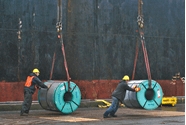Steel Products Prices North America

Steel Imports Decline in February, Defy Prediction in the Months Ahead
Written by Tim Triplett
March 13, 2022
Steel import permit applications for February totaled 2,274,000 net tons—a 24.5% decrease from the 3,013,000 permit tons recorded in January and a 25.3% decrease from the January final imports total of 3,044,000. Import permit tonnage for finished steel in February was 1,759,000, down 22.8% from the final imports total of 2,279,000 in January, reported the American Iron and Steel Institute, based on the latest Commerce Department data.
As of the end of February, steel prices in the U.S. had declined by nearly 50% from record highs last year to levels where foreign mills no longer had a price advantage. Steel Market Update pegged the benchmark price for hot rolled coil on March 1 at $1,000 per ton. Most buyers have been in an inventory-reduction mode for the past few months, postponing purchases as they waited to see how low prices would go. Thus many have reduced orders from mills, both domestic and foreign. Therefore, the decrease in imports in February comes as no surprise.
For the first two months of 2022 (including February SIMA permits and January final imports), steel imports totaled 5,318,000 net tons, a 23.1% increase, including 4,038,000 tons of finished steel, a jump of 51%, compared with the same period in 2021. Imports held a 23% share of the U.S. finished steel market year to date through February, AISI reported.
Steel imports with large increases in February permits versus final January imports include reinforcing bars (up 75%), heavy structural shapes (up 28%) and light shapes bars (up 26%). Products with significant year-to date increases included wire rods (up 118%), oil country goods (up 107%), sheets and strip all other metallic coatings (up 102%) cold rolled sheet (up 100%), and sheets and strip hot-dipped galvanized (up 71%).
Through the first two months of 2022, the largest exporters to the U.S. were Canada (1,030,000 tons, down 5% from the same period last year), Mexico (985,000 tons, up 60%) and Brazil (705,000 tons, down 35%), AISI said.
Steel prices appear to have bottomed in the first week of February and are on the upswing as U.S. mills raise prices in response to big jumps in global raw material costs triggered by the war in Ukraine. Normally, rising prices in the U.S. would attract more steel from overseas, but mills all over the world are dealing with higher costs due to the disruption of slab, pig iron and scrap supplies from Ukraine and Russia. Ripple effects from the conflict in Eastern Europe make prices and the level of steel imports into the U.S. risky to predict in the months ahead.
By Tim Triplett. Tim@SteelMarketUpdate.com

Tim Triplett
Read more from Tim TriplettLatest in Steel Products Prices North America

Nucor slows HRC price climb with $5/ton increase
After eight weeks of double-digit price increases on hot-rolled (HR) coil, Nucor slowed the price rise this week with an increase of $5 per short ton.

Domestic CRC prices surge ahead of imports
The price spread between stateside-produced CR and imports reached its widest margin in over a year.

Evraz raises plate prices $160/ton
Evraz North America (NA) has followed Nucor and SSAB with a plate price increase of its own: up $160 per short ton (st). The increase was effective immediately for all new orders of carbon, high-strength low-alloy, and normalized and quenched-and-tempered plate products, as well as for hot-rolled coil, the steelmaker said in a letter to […]

Nucor lifts HR coil to $820/ton
Nucor has increased its consumer spot price (CSP) for hot-rolled (HR) coil for a fourth consecutive week.

Nucor pushes HR spot price to $790/ton
Nucor increased its consumer spot price (CSP) for hot-rolled (HR) coil to $790 per short ton (st) on Monday, Feb. 10 – a $15/st bump vs. last week. The Charlotte, N.C.-based company has raised its weekly CSP by $40/st over the past three weeks after maintaining tags at $750/st since Nov. 12, according to SMU’s […]
